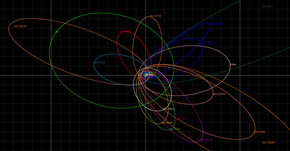 | |
| Discovery[1][2] | |
|---|---|
| Discovered by | Dark Energy Survey |
| Discovery site | Cerro Tololo Obs. |
| Discovery date | 17 January 2015 (first observed only) |
| Designations | |
| 2015 BP519 | |
| Caju (nickname)[a] | |
| TNO[3] · ESDO[4] · ETNO distant[2] | |
| Orbital characteristics[3] | |
| Epoch 27 April 2019 (JD 2458600.5) | |
| Uncertainty parameter 5 | |
| Observation arc | 3.22 yr (1,176 d) |
| Aphelion | 820 AU |
| Perihelion | 35.2 AU |
| 428.03 AU | |
| Eccentricity | 0.9178 |
| 8856 yr (3,234,488 d) | |
| 358.39° | |
| 0° 0m 0.36s / day | |
| Inclination | 54.125° |
| 135.11° | |
| ≈ 7 September 2058[5] ±1 month | |
| 348.37° | |
| Physical characteristics | |
| 524 km (est.)[6] 584 km (est.)[4] | |
| 0.08 (assumed)[6] 0.09 (assumed)[4] | |
| 21.5 | |
| 4.4[2][3] | |
2015 BP519, nicknamed Caju,[a] is an extreme trans-Neptunian object from the scattered disc on a highly eccentric and inclined orbit in the outermost region of the Solar System.[7] It was first observed on 17 January 2015, by astronomers with the Dark Energy Survey at Cerro Tololo Observatory (W84) in Chile.[1][2] It has been described as an extended scattered disc object (ESDO),[4] and fits into the group of extreme objects that led to the prediction of Planet Nine, and has the highest orbital inclination of any of these objects.[a]
- ^ a b Cite error: The named reference
MPC-CEN-SDO-listwas invoked but never defined (see the help page). - ^ a b c d Cite error: The named reference
MPC-objectwas invoked but never defined (see the help page). - ^ a b c Cite error: The named reference
jpldatawas invoked but never defined (see the help page). - ^ a b c d Cite error: The named reference
johnstonsarchive-TNO-listwas invoked but never defined (see the help page). - ^ JPL Horizons Observer Location: @sun (Perihelion occurs when deldot changes from negative to positive. Uncertainty in time of perihelion is 3-sigma.)
- ^ a b Cite error: The named reference
Brown-dplistwas invoked but never defined (see the help page). - ^ Cite error: The named reference
Becker-2018was invoked but never defined (see the help page).
Cite error: There are <ref group=lower-alpha> tags or {{efn}} templates on this page, but the references will not show without a {{reflist|group=lower-alpha}} template or {{notelist}} template (see the help page).